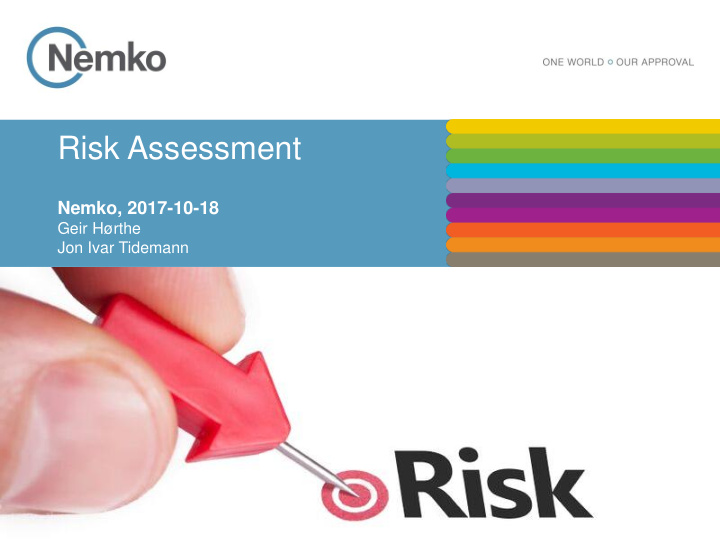



Risk Assessment Nemko, 2017-10-18 Geir Hørthe Jon Ivar Tidemann
2 13.06.2017
Risk? Speed? Dark? Wet? Distance? 3
Risk? Probability Speed? Dark? Wet? Distance? 4
Risk? Probability Car? Size? Speed? Fire Truck? 5
Risk? Probability Severity Car? Size? Speed? Fire Truck? 6
Risk? Probability x Severity = Risk 7
Risk? Probability Severity 8
Risk? Risk analysis = what are the risks? Risk evaluation = is risk acceptable? Risk assessment 9
Risk level – what is ok? Probability Severity 10
Risk standard - Inherent Hazard - User - Location - Use / Misuse - Faults - Statistics 11
Risk report Product’s hazards: User: - Sharp - Age, disability , trained .. - Kinetic energy - Intended / non intended user - Fire - Use / Misue - etc - etc Describe scenario: - Child breaks lamp and gets a burn - etc. Level of Severity: Probability: - cut - e.g. < 1/100 000 - burn - etc 12
Risk report Level of Severity: Probability: - cut - e.g. < 1/100 000 - burn - etc Find Risk level: - use risk table. Acceptable risk? 13
Risk reduction 1. Reduce inherent hazard 2. Safeguarding 3. Information NEMKO EUROPE 14 13.06.2017
Risk reduction – an example 1. Reduce inherent hazard 2. Safeguarding 3. Information 15
Risk assessment – part II Nemko, 2017-10-18 Jon Ivar Tidemann
You have to - mandatory risk analysis from April 20 th , 2016 • LVD Directive 2014/35/EU, Annex III, 2. The technical documentation shall include an adequate analysis and assessment of the risk(s). The Blue Guide gives further information. This analysis has to be documented and included in the technical documentation, unless risk assessment is included in the harmonized standard. ( Nemko comment-last part apply for EN 61010, Machinery products, Medical products) 17
Starting to define hazards Design knowledge Harm Use Reduce below RISK Tolerable level Incidents Accidents
Hazard identification in all life phases • All life phases to be considered • a) transport; • b) assembly and installation; • c) commissioning; • d) use; • e) de-commissioning, dismantling and disposal as far as safety is concerned.
Where to find Cenelec Guide 32 https://www.cenelec.eu/membersandexperts/referencematerial/cenelecguides.html TITLE 21 20.10.2017
Annex A of the guide
Annex D of the guide
Example 1- 25 20.10.2017
What is the risk for this to happen? • Assumptions: • It is a child of age 1-3 in 5% of homes having an iron • User of the iron is away for some seconds in 1% of situations. • Child try to raise and catch the iron in 10% of situations TITLE 26 20.10.2017
Sequence for accident to happen • Iron need to tilt and fall down-50% probability • What happens then? • Hit in the head • Falls down and brakes so child can get electrical shock • Falls down on the body of the child • Does not brake and child take it up to iron on body • Falls down and scares the child to run away If child grips cord-then 50% PROBABILITY TO BE HIT! Otherwise approx 25% TITLE 27 20.10.2017
Overall probability and severity Probability: 1/20 x 1/10 x 1/100 x 1/2 x 1/2 = 1/ 80 000 TITLE 28 20.10.2017
Result – Low risk TITLE 29 20.10.2017
Example 2
Example 2 - Listing of hazards and calculations Injury scenario Injury type Severity Probability of injury Overall possibility Risk (include user) and body (1-4) (L/M/H/S) part Are all the risks tolerable for your company? Use the 3 step method for reduction of risk
Example 2 - Tolerable level and the 3 step method Step Reducing hazard 1 - LED instead of Incandescent, - Plastic enclosure instead of Glass, - Avoid child appealing design 2 - Batteries or below 42 volts , - Fixed instead of movable 3 Not recommended
Final documentation to put in technical file • Cenelec Guide 32, Annex D: NEMKO EUROPE 33 13.06.2017
Services from Nemko • Services for Risk Assessment: • Seminars • Webinars • In-house seminars • Risk Assessment according to Cenelec Guide 32. Contact your local Key Account Manager
Recommend
More recommend